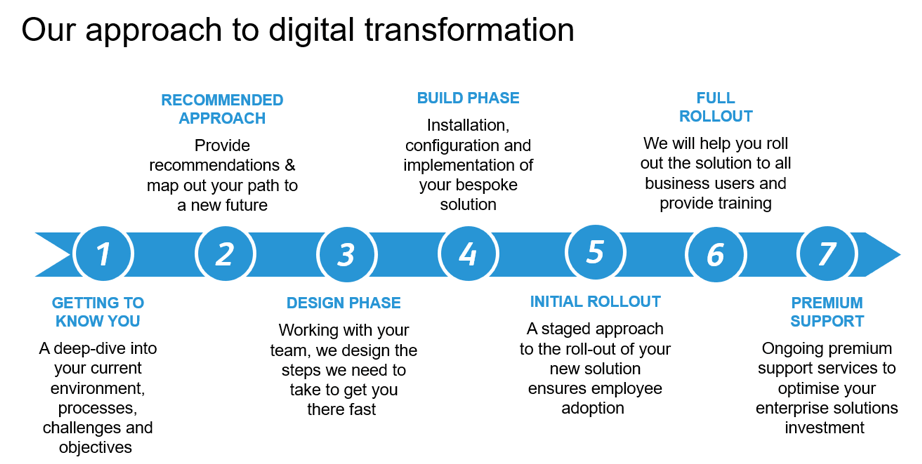Accelerate digital transformation with intelligent document solutions
Most organizations today are chasing a digital agenda in some shape or form. Although progress is being made, the way to accelerate that journey to digital is to transform the very essence of the business — which is through its documents.
Organizations, especially those that aren’t digital-only or digital-first, tend to work with a lot of paper forms and documents. Be it invoices, contracts, or official letters, organizations spend a lot of money, time, and energy (needlessly) creating, maintaining, and managing documents.
Their resources, especially in the increasingly digital world that we live in can be better spent on digitizing the documents and moving them to the cloud where they can serve the various business units and divisions, thereby putting the information on the documents to better use.
Without digitized documentation, companies are unable to leverage intelligent solutions to drive wider-ranging transformation efforts forward.
Those efforts might include robotic process automation (RPA) for tasks like automating the recording of inward invoices, for example, that can remove humans from the equation, increasing efficiency and reducing errors.
More complex innovations such as machine learning and artificial intelligence, on the other hand, require that companies gather all information from paper documents, by digitizing and feeding them onto a secure platform that can help the organization analyze and draw insights to inform strategy and decision-making processes.
Ultimately, most workflows demand some sort of digitization when paper documents are used, because that’s what helps drive the organization into the digital age. It’s what helps deliver a better customer, student, or citizen experience.
There’s a debate about why companies don’t do away with paper forms and printed documents altogether. Given the various statutory rules and regulations, that’s not an option – at least not immediately. Moving towards that goal, however, requires that companies get started on their digital, paperless journey now.
To help our audience, Tech Wire Asia has reviewed and shortlisted a few of the most amazing solutions on the market.
FUJI XEROX
Digital transformation isn’t a simple case of deploying a solution or two to bring about a paperless office, or a series of inter-application automation robots – although Fuji Xerox offers both of those platforms, among hundreds of other possibilities.
Instead, as the company’s very long history as a tech innovator attests, being a success, long-term, is about getting the business processes right first just as much as any raft of software systems.
Aligning business processes and technology to carry out those processes is the critical means to an end here, and the overall result should be a streamlining, a massive boost to efficiency, and all the business units working towards a common goal.
That position should be achieved, and then maintained and attenuated, irrespective of the badge on the front of the hardware, or the logo on software’s splash screen.
That takes a partner, not a supplier. Fuji Xerox specialises in business technologies proven to bring about change for scalability, high standards of data governance, efficiency and interoperability. But of course, even this technology specialist knows that digital transformation starts a long way back from anything digital:

To better understand what Fuji Xerox Australia offers to customers, read about its business-savvy solutions by following this link to an in-depth look at the company.
OPENTEXT
OpenText helps create a better way for organizations to work with information, on-premise or in the public cloud. It provides enterprise software for digital transformation with 80 percent of the world’s Fortune 1000 companies by using OpenText EIM (Enterprise Information Management) solutions to grow faster, lower their operational costs, and reduce information governance and security risks.
The OpenText EIM offerings have been designed to automate the flow of enterprise information, from engagement to eventual insight. Across all industries, organizations are using OpenText solutions to solve their most complex business problems, ranging from engagement, capture, and process to collaboration, discovery, and insight.
EIM pulls the various strands of data and information together which flow through the enterprise into one unifying form, and therefore, can offer a range of information management services which covers all the bases.
OpenText’s information applications can be tailored: for instance, various data collation suite combinations might be paired with components from development platforms to form flexible applications.
The company offers business trading platforms and networks, AI capabilities (under the name Magellan), plus data lake management, big data collation & analysis, and a whole raft of business-oriented solutions.
LASERFICHE
Laserfiche knows that digital transformation comprises a series of steps. Simply moving paper documents into a digital space doesn’t equal transformation or order – media needs to be organized, secured, and be accessible in individualized ways. Reducing complexity in the workplace by making documents and different formats disappear into silicon does not create order from chaos, it merely moves it.
The company’s solutions not only help organize and categorize information, drawing it out of silos, but help companies to automate and streamline the processes that manage it. By automating existing manual processes, organizations drive efficiency and remove bottlenecks associated with manual-processing practices.
Automated scanning of documents, electronic uploads from mobile devices and media imports allow the creation of powerful archives of information, searchable 24/7, and configured in individualized structures for each member of staff, according to privilege levels.
Pulling all the necessary elements required for deep digital transformation requires a truly joined-up vision, and Laserfiche has a five-step plan to realize that vision.
The company’s model catalogs, organizes and automates information flow through the workplace, creating positive changes in working practices, and streamlining data usage. The final step in the Laserfiche plan allows companies to continue to transform by analyzing the performance of your data via “descriptive analytics”.


